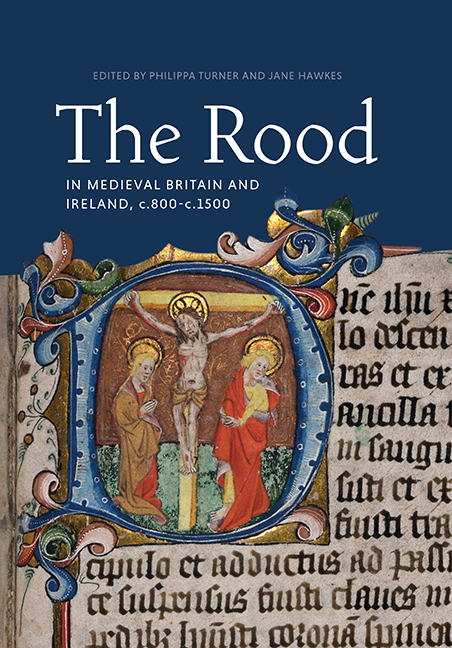Book contents
- Frontmatter
- Contents
- List of Illustrations
- List of Contributors
- Acknowledgements
- List of Abbreviations
- 1 Introduction: Rethinking the Rood
- 2 Approaching the Cross: The Sculpted High Crosses of Anglo-Saxon England
- 3 The Mark of Christ in Wood, Grass and Field: Open-Air Roods in Old English Medical Remedies
- 4 Twelfth-Century English Rood Visions: Some Iconographic Notes
- 5 Crosses, Croziers and the Crucifixion: Twelfth-Century Crosses in Ireland
- 6 From Religious Artefacts to Symbols of Identity: The Role of Stone Crosses in Galician National Discourse
- 7 The Rood in the Late Medieval English Cathedral: The Black Rood of Scotland Reassessed
- 8 The Cross of Death and the Tree of Life: Franciscan Ideologies in Late Medieval Ireland
- 9 Heralding the Rood: Colour Convention and Material Hierarchies on Late Medieval English Rood Screens
- 10 Reframing the Rood: Fifteenth-Century Angel Roofs and the Rood in East Anglia
- Bibliography
- Index
- Already Published
- Plate Section
4 - Twelfth-Century English Rood Visions: Some Iconographic Notes
Published online by Cambridge University Press: 07 November 2020
- Frontmatter
- Contents
- List of Illustrations
- List of Contributors
- Acknowledgements
- List of Abbreviations
- 1 Introduction: Rethinking the Rood
- 2 Approaching the Cross: The Sculpted High Crosses of Anglo-Saxon England
- 3 The Mark of Christ in Wood, Grass and Field: Open-Air Roods in Old English Medical Remedies
- 4 Twelfth-Century English Rood Visions: Some Iconographic Notes
- 5 Crosses, Croziers and the Crucifixion: Twelfth-Century Crosses in Ireland
- 6 From Religious Artefacts to Symbols of Identity: The Role of Stone Crosses in Galician National Discourse
- 7 The Rood in the Late Medieval English Cathedral: The Black Rood of Scotland Reassessed
- 8 The Cross of Death and the Tree of Life: Franciscan Ideologies in Late Medieval Ireland
- 9 Heralding the Rood: Colour Convention and Material Hierarchies on Late Medieval English Rood Screens
- 10 Reframing the Rood: Fifteenth-Century Angel Roofs and the Rood in East Anglia
- Bibliography
- Index
- Already Published
- Plate Section
Summary
The twelfth century witnessed some of the most fundamental changes in depictions of the crucified Christ in north-west Europe. Images of Christ standing triumphantly on the cross yielded dominance to those of him suffering; depictions of Christ crucified with three nails rather than four made their first appearances; as, arguably, did those showing him crucified with the crown of thorns on his head. Where the patterns and paces of these changes are attested to at all by the surviving artistic record, they are so only partially. This discussion, therefore, will explore an alternative source of evidence, written descriptions of visions of the crucified Christ, and consider the extent to which they could be used to increase our understanding of developments in English twelfth-century crucifixion iconography.
It has not been unusual for scholars to suppose that the details of the images described in medieval visions and apparitions, of which there are a good number, might represent a sort of subconscious ludus – a kind of involuntary, imaginative riff – on familiar imagery first seen by the visionary in the material world around them. Neither is it entirely an assumption. Just as Steven Justice has made a very good case for a greater awareness of psychological complexity, albeit unlabelled and unrefined, amongst medieval men and women with regard to miracles, so we should accord them greater credit than some sometimes do when it comes to relating the sight of the eyes to the sight of the mind (or soul). As others have noted, when the mother of the French Benedictine Guibert of Nogent (c. 1055‒1124) had a vision of the Blessed Virgin Mary, she was entirely aware that it was an image of the Virgin of Chartres that she saw: it was how she recognised her. Similarly, a monk from Monte Cassino knew that it was the archangel Michael that visited him, we are told, because he had learned the saint's likeness from a painting. These accounts go further than simply recognising the connection: it is the fact that the visions resemble images known to the visionaries in the material world that helps them to accept their visions’ authenticity.
- Type
- Chapter
- Information
- The Rood in Medieval Britain and Ireland, c.800-c.1500 , pp. 45 - 58Publisher: Boydell & BrewerPrint publication year: 2020

